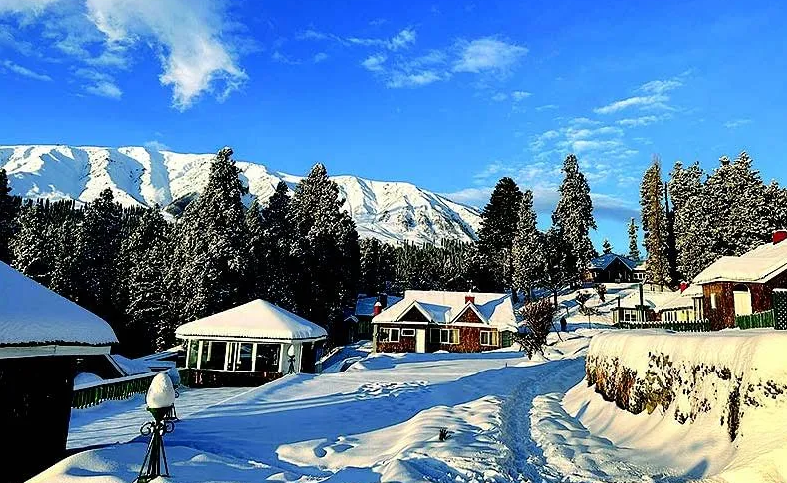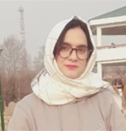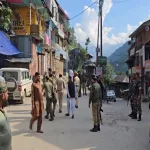The Kashmir valley received fresh seasonal snowfall of the winter season of ‘Chillai Kalan’, the harshest winter period of 40 days that started on December 21 every year turns the Kashmir valley in a thick layer of white snow all across areas as the minimum temperatures decreased at most places in Kashmir valley.
The valley continued to reel under intense cold conditions, leading to the freezing of several water bodies and water supply lines in many areas of the valley is experiencing below-normal maximum as well as minimum temperatures for this time of the season.
Kashmir has entered the harshest chapter of its winter, Chillai Kalan, marking a 40-day stretch of intense cold that began on December 21 this year. This unforgiving period, lasting until January 31, will be followed by the 20-day Chillai Khurd (small cold) and the 10-day Chillai Bachha (baby cold), stretching winter’s icy grip well into March.
The name ‘Chillai Kalan’, derived from Persian, aptly translates to “Major Cold,” signifying the peak of the region’s winter hardships, characterized by biting cold, heavy snowfall, and freezing night temperatures.
The Kashmir Valley experiences its coldest winter night in five decades with temperatures plunging to minus 8.5°C, signalling the start of Chillai Kalan, a period marked by severe cold and heavy snowfall, impacting daily life and spawning traditional winter practices and attire.
On December 21, 2024 the Kashmir Valley woke up to an icy embrace, recording its coldest winter night in the last five decades with temperatures plunging to a bone-chilling minus 8.5 degrees Celsius. This dramatic drop in the temperatures marks the onset of Chillai Kalan, or ‘the mighty cold’.
The meteorological phenomenon, instead of pausing life, gave birth to traditions and practices that added vibrant hues to Kashmir’s culture as the Kashmir Valley undergoes a profound transformation. Nights become intensely cold, with daytime temperatures struggling to rise above single digits. The snowfall during this period is substantial, often leading to the freezing of water bodies like the Dal Lake and causing water supply lines to freeze, disrupting daily life. This freezing is good news as it indicates prosperity and chances of bumper crops particularly for farmers from the apple-growing segment.
During this period, people often stay inside due to bone-chilling cold. Kashmiris adapt to the severe cold by embracing traditional practices and attire. The ‘pheran’, a long woolen cloak, becomes essential winter wear, providing warmth and comfort. Pheran Day (also International Pheran Day or World Pheran Day) is celebrated in Kashmir on 21 December as the first day of Chillai Kalan.
Srinagar’s lowest-ever minimum temperature in this month was minus 12.8 degrees Celsius on December 13, 1934, while the now-third lowest was minus 7.9°C, observed on December 13, 1986.
During Chillai Kalan, many Kashmiri families prepare ‘Shabdeg’ on the first day of ‘Chillai Kalan’. Meat is slow cooked with turnips and spices in an earthen vessel during the night intervening December 20-21, to mark the onset of the coldest phase of the season.
During its 40 days, the Chillai Kalan leaves no chance to put people through the most difficult of hardships. Generally, however, due to the icy winds in Chillai Kalan, the entire valley is gripped by severe cold. The ongoing cold wave is said to reach its peak with Kashmir’s mountains covered in snow for weeks, and the famous Dal Lake also reaching freezing point until the end of January.
As the harsh winter period begins, the demand for ‘Kangri’ (earthen fire pot filled with charcoal) has risen sharply as the residents prepare to face the bone-chilling cold. People stock eatables and other essential commodities for the period as the national highway often closes due to heavy snowfall.
Snow begins falling in Kashmir around late October at higher altitudes, like Gulmarg and Sonamarg and main snowfall season however, occurs between December and February, with Gulmarg, Pahalgam, and Sonamarg being the top spots for snowfall lovers. Towards the advent of winter, Kashmir’s temperature drop causes more and more rains and even snow. The temperature mostly stays above 0 degree C in the early months of winter that comes down with the falling of the snow.
January is the peak month of snow and cold makes it the best month to visit Kashmir for snowfall. In this month temperature can go down to -6 degrees C and whole atmosphere is filled with mist and snow. Roads and tourist attractions, however, are open and Kashmir is ready to embrace you in its welcoming and refreshing beauty that find its match nowhere in the world.
Viewing snow falling on the frozen Dal while enjoying a warm cup of Kehwa during the Chill January Air is your calling! Apart from this, Kashmir also offers a serene winter for the more artistic and romantic of tourists. The common streets of Kashmir are a thing of beauty to watch in the freezing January.
February is adieu to the winter and the cold of Kashmir. The snow starts melting, and the sun shines on the frozen meadows of snow again. In this month, the Gondola in Gulmarg is the best thing to watch not only for the serene view it provides, but also for enjoying the rebirth of nature in one form and the farewell of other forms. Enjoying the sun shining on the frozen meadows while travelling through air in a Cable Gondola in the meadows and forests of Gulmarg is a divine view.
February also brings an invitation to visit Dachigam National Park, not far from the Mughal Garden Harwan. Snowfall can also occur in November and March. Mostly, snowfall across Kashmir is seen in December, January, and February, but higher peaks like Pirki Gali and Sinthan Top receive late snow in March, offering a beautiful destination.
There are times when Kashmir flourishes with maple in the fall, and green pasture in the summer but winter in Kashmir is special. Nothing in the world looks prettier than how top tourist places in Kashmir like Gulmarg, Sonmarg, Pahalgam, and Srinagar appear, all cast in the snow. Kashmir thrives in a dreamy surrounding. The entire valley is covered with a blanket of snow. Life stops during winter as one can’t find too many people around. Stunning escapades loom largely bejewelled with imposing mountain peaks in the backdrop, and partially frozen pine trees cut the picture of a mesmerizing sight around.
(The author can be mailed at [email protected]. X/Twitter: @haniefmha)








